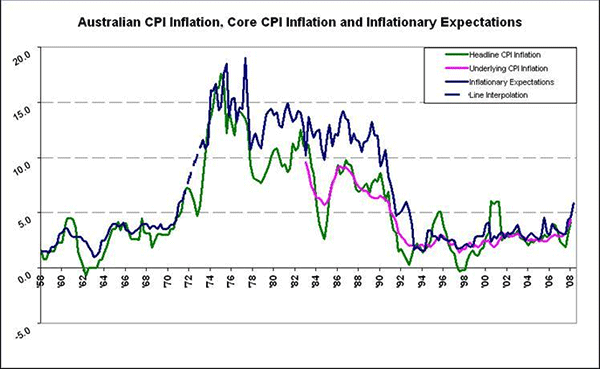The economy is slowing sharply but inflationary expectations are accelerating. This is the dire dilemma facing the Reserve Bank as its board meets today.
As usual, Henry's analysis takes a long-term view. The graph (see below) shows inflation and inflationary expectations from 1959 to May this year. Versions of this graph used before have shown inflation picking up from zero in 1998, itself an ominous trend.
During Ian Macfarlane's time as governor, the warnings illustrated by this trend were ignored. Monetary policy was tightened too little, too late. The point that "too little, too late" would lead to interest rates higher than they need be was ignored.
Advertisement
Essentially, I believe, this was due to an inability to read the economy and its essential dynamism (confounded by an inability to take advice, freely offered, from someone with long experience in these matters).
Since Glenn Stevens has taken the reins of the Reserve, cash rates have been raised four times, once during an election campaign and two months in a row earlier this year.
The latest puff piece about Stevens, in last Friday's Australian Financial Review, labelled him "The Enforcer". Certainly he seems more on the case than his predecessor, with a lesser psychological need to be liked.
But is "The Enforcer" fighting the last war? Or has he quietly adopted Henry's advice that interest rates need not be driven too high to fight a global surge in the price of oil, foodstuffs and other commodities?

Certainly the puff piece referred to emphasises the flexibility of the Reserve in pursuing its inflation target. At this time in the economic cycle anecdotes count far more than official statistics, which necessarily provide a view obtained by a rider looking backwards.
Advertisement
The statistics show a clearly slowing economy. Retail sales have slowed, investment intentions have been reduced, there is one month of falling employment data, and business and household confidence is well down, in some cases to levels that in the past have signalled recession. Wages apparently remain under control. Both the ABS data for March and the wage data in the national accounts suggest wages growth with a 4 in front of it, but no run-away surge.
Against this we have an economy that in the post-World War II era has always shown great resilience and an inherent tendency to inflation. When Henry's editor left the Reserve in 1988, forced out by Paul Keating as it happens, he wrote that one of the lessons he had learned as its most senior economist was: "My conjecture is that the Australian economy is likely to show a continued tendency to grow too strongly for comfort."
Then there is the ongoing reality of the resources boom. There are plenty of backward-looking statistics to show this.
It is when we move to the anecdotes that the story gets interesting. Australia's miners are struggling to cope with China's insatiable demand for raw materials. The latest prices agreed for iron ore show an extraordinary 85 per cent hike.
Talk to a mining man and you will find someone struggling to get rubber tyres for his trucks and workers for his mines. Inflation is a powerful reality in the mining world and is spreading rapidly to include mine suppliers.
Farmers are not immune, battling drought, but with global food prices showing the prize for those who can produce crops or beasts.
A Sydney farmer, with important part-time jobs in the CBD, told Henry recently of his problem with steel star-pickets. His farm manager told him that the price of star-pickets was about to rise 7 per cent. As our Sydney farmer was able to earn 8 per cent in the money market he said not to buy the pickets. Then his manager said there was another 7 per cent price hike to come, very likely to be followed by a 15 per cent hike.
With the price of iron ore doubling in short order, the price of steel must follow. With the price of oil rocketing, the price of plastics has to follow. This is on top of the escalating cost of getting to work, with Australia's inadequate public transport too often providing an inadequate alternative to the family car.
How long can we ask ordinary non-mining workers to maintain wage constraint when the costs of food and transport are rocketing, along with their rent or mortgage?
But there is another side to the story of Australia's mining boom. What is its impact in squeezing the non-mining industries?
On the same day Henry spoke with his Sydney farmer he saw the principals of a PR firm. "How is the economy going?" they asked anxiously after Henry's immediate issue was dealt with. They had asked because their clients in the non-mining sector were almost all undertaking a round of tightening, with 20 per cent the highest target number for planned job cuts. The relevant clients include a number of blue chip Australian businesses, and what is happening is no routine pruning.
Presumably the board of the Reserve will have its own set of anecdotes to consider today. That is why the board contains leaders from the real world of commerce. The most important statistic Stevens will ponder is that for inflationary expectations of consumers, measured each month by the Melbourne Institute.
The May reading showed a sharp increase, to 5.9 per cent. As the graph shows, this measure has been rising for some time. Indeed, every inflation indicator is pointing up. Now the trend from 1998 can no longer be ignored.
The danger is that "The Enforcer" will enforce an outdated orthodoxy and do more damage to Australia's non-mining economy.
If the old orthodoxy is in place, the Reserve will raise interest rates again today.
If it has heeded the warnings of experienced observers, it will stay its hand. Not abandoning or suspending inflation targeting, just applying its claimed "flexibility".